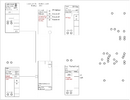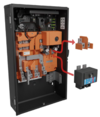Lol you actually found those LOTO clips? Yeah I think those clips should be a good compromise between putting lots of blades next to the ESS or putting a sub panel full of OCPDs next to the ESS. Well, unless you're doing an install in Contra Costa County.
In case it got lost in this thread... when I had the CoCo inspector on site to challenge their interpretation of 706.7, he called the home office and was told by Garth Robertshaw (heads up all of Contra Costa's inspectors) that he agreed the LOTO clip works for 706.7(B). But, he said that the clip would only apply if the OCPD with the LOTO clip were within 5 feet of the ESS. If the ESS were on the other side of a wall, then he would force 707 (E). Basically Garth thinks 706.7(B) with LOTO clip is sufficient for the safety of the electrical worker who comes on site to do work. But 706.7(E) is necessary for the safety of a firefighter who needs to de-energize the house. So no matter what the site placard says, he wants disconnecting means next to the ESS.
Basically you'd have to put the TEG2 and internal panelboard right next to the ESS, but then I think that configuration would still need a disconnecting means outside for fire safety since the disconnecting means are supposed to be near the MSP outside. I'm super confused about all this this either way haha.
TLDR, molded case OCPDs next to the ESS is probably the better bet for both electrical worker and fire worker safety regardless if the ESS is installed inside or outside in Contra Costa.
Also, regarding that issue H2ofun had in Rocklin (I think it's Rocklin), their checklist uses the term "disconnects" a bit too literally without defining that OCPDs are valid "disconnecting means". So while you may know 706.7 (E)(1) expressly allows molded case breakers as a disconnecting means; the OCPD by strict definition is not a "disconnect". That's why my cool avatar picture was searchable with the term "disconnect".
In case it got lost in this thread... when I had the CoCo inspector on site to challenge their interpretation of 706.7, he called the home office and was told by Garth Robertshaw (heads up all of Contra Costa's inspectors) that he agreed the LOTO clip works for 706.7(B). But, he said that the clip would only apply if the OCPD with the LOTO clip were within 5 feet of the ESS. If the ESS were on the other side of a wall, then he would force 707 (E). Basically Garth thinks 706.7(B) with LOTO clip is sufficient for the safety of the electrical worker who comes on site to do work. But 706.7(E) is necessary for the safety of a firefighter who needs to de-energize the house. So no matter what the site placard says, he wants disconnecting means next to the ESS.
Basically you'd have to put the TEG2 and internal panelboard right next to the ESS, but then I think that configuration would still need a disconnecting means outside for fire safety since the disconnecting means are supposed to be near the MSP outside. I'm super confused about all this this either way haha.
706.7 (B) Remote Actuation. Where controls to activate the disconnecting means of an ESS are not located within sight of the system, the disconnecting means shall be capable of being locked in the open position in accordance with 11.25, and the location of the controls shall be field marked on the disconnecting means.
706.7 (E)(1) A disconnecting means shall be provided at the energy storage system end of the circuit. Fused disconnecting means or circuit breakers shall be permitted to be used.
706.7 (E)(2) A second disconnecting means located at the connected equipment shall be installed where the disconnecting means required by 706.7(E)(1) is not within line of sight of the connected equipment.
TLDR, molded case OCPDs next to the ESS is probably the better bet for both electrical worker and fire worker safety regardless if the ESS is installed inside or outside in Contra Costa.
Also, regarding that issue H2ofun had in Rocklin (I think it's Rocklin), their checklist uses the term "disconnects" a bit too literally without defining that OCPDs are valid "disconnecting means". So while you may know 706.7 (E)(1) expressly allows molded case breakers as a disconnecting means; the OCPD by strict definition is not a "disconnect". That's why my cool avatar picture was searchable with the term "disconnect".
Last edited:




